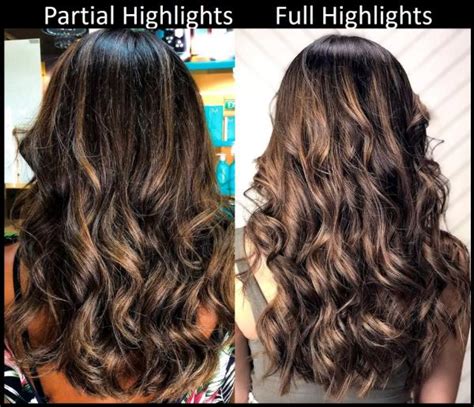Understanding the Differences
Partial highlights and full highlights are two popular hair coloring techniques that vary in extent and intensity.

- Partial Highlights: Focus on select strands, creating a more subtle, natural-looking effect. Typically cover 20-50% of hair.
- Full Highlights: Apply color to a significant portion or all of the hair, resulting in a more dramatic, uniform color change. Cover 50-100% of hair.
Benefits of Partial Highlights
- Less Damaging: Involve less bleach and processing time, reducing the risk of hair breakage.
- More Natural: Mimic the natural sun-kissed look, blending in with the base color.
- Lower Maintenance: Touch-ups required less frequently, typically every 3-6 months.
- Affordable: Generally less expensive than full highlights due to less product and processing required.
Benefits of Full Highlights
- Dramatic Transformation: Create a bold, eye-catching look.
- Versatile: Can be customized to create different shades and effects, from subtle to vibrant.
- Hides Gray: Effective for covering gray hair and blending it with natural tones.
- Corrects Color: Helps fix uneven color or unwanted tones.
Choosing the Right Option
The choice between partial and full highlights depends on personal preferences and desired outcome:
- Partial Highlights: Ideal for those seeking a subtle change, a natural-looking glow, or less maintenance.
- Full Highlights: Suitable for those wanting a more noticeable transformation, hiding gray hair, or correcting color.
Table 1: Characteristic Comparison
| Characteristic | Partial Highlights | Full Highlights |
|---|---|---|
| Coverage | 20-50% of hair | 50-100% of hair |
| Effect | Subtle, natural | Dramatic, uniform |
| Damage | Less damaging | More damaging |
| Maintenance | Less frequent touch-ups | Frequent touch-ups |
| Cost | Less expensive | More expensive |
Table 2: Suitability Guide
| Hair Type | Partial Highlights | Full Highlights |
|---|---|---|
| Fine, damaged hair | Yes | No |
| Thick, healthy hair | Yes | Yes |
| Gray hair | Yes (for natural coverage) | Yes (for complete coverage) |
| Dyed hair | Yes (for color correction) | Yes (for dramatic change) |
Tips and Tricks
-
For Partial Highlights:
- Use foils to isolate target strands and prevent unwanted color transfer.
- Apply bleach sparingly to avoid over-processing.
- Consider using a developer with a lower volume for more subtle results.
-
For Full Highlights:
- Apply color evenly throughout the hair to achieve a uniform finish.
- Use a developer with a higher volume for more dramatic lightening.
- Consider toning after bleaching to enhance color and reduce brassiness.
How-to: Step-by-Step Guide
Step 1: Preparation
- Wash and dry hair thoroughly.
- Section hair into manageable parts using clips.
Step 2: Application
Partial Highlights:
– Select target strands and weave them through foils.
– Apply bleach and developer to isolated strands.
Full Highlights:
– Apply bleach and developer directly to hair, avoiding the roots.
– Use a brush or comb to distribute color evenly.
Step 3: Processing
- Leave bleach in for the time specified on the product instructions.
- Monitor progress to avoid over-processing.
Step 4: Rinsing
- Rinse hair thoroughly with cool water.
- Shampoo and condition as usual.
Step 5: Toning (Optional for Full Highlights)
- Apply toner to color-treated hair to enhance color and reduce unwanted tones.
- Rinse after recommended time.
Pros and Cons Comparison
Table 3: Pros of Partial Highlights
| Pros |
|—|—|
| Subtle, natural look |
| Less damaging |
| Lower maintenance |
| Affordable |
Table 4: Cons of Partial Highlights
| Cons |
|—|—|
| Less noticeable transformation |
| May require more frequent touch-ups if roots grow out |
Table 5: Pros of Full Highlights
| Pros |
|—|—|
| Dramatic transformation |
| Versatile |
| Hides gray hair |
| Corrects color |
Table 6: Cons of Full Highlights
| Cons |
|—|—|
| More damaging |
| More frequent touch-ups required |
| More expensive |
Creative “Dimensional Highlights”
For a more innovative approach, consider “dimensional highlights” that blend different shades of highlights to create a multi-dimensional effect. This technique adds depth, texture, and interest to hair.
Conclusion
Whether choosing partial or full highlights, the goal is to enhance natural beauty while expressing personal style. By understanding the differences, benefits, and techniques involved, you can make an informed decision to achieve the desired hair transformation.
